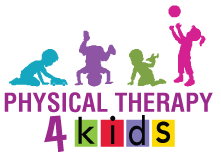What is Torticollis & Plagiocephaly?
Torticollis is defined as a muscular tightness in the muscles on one side of the neck.
The Sternocleidomastoid muscle is most commonly affected. Muscles on the opposite side of the affected side may become weak due to the abnormal head posture. The most optimal time to begin Physical Therapy for Torticollis is between 2 weeks to 2 months of age. However, we evaluate babies at any age when a head tilt is observed. Early diagnosis and treatment is the key to success.
With Right Torticollis, the baby’s head will typically look tilted toward the right shoulder and rotated toward the left shoulder.
With Left Torticollis, the baby’s head will typically look tilted toward the left shoulder and rotated toward the right shoulder.
Plagiocephaly is defined as an abnormal head shape or flat head syndrome.
Plagiocephaly is characterized by a flattening on the back of the skull or on one side of the skull. It can occur before or after birth and can be due to abnormal positioning in utero, prematurity, or from lying on the back or on one side of the head for too long after birth due to decreased tummy time. This condition can also be caused by the overuse of a car seat, stroller, bouncer seat, or swing. There is often some facial asymmetry seen. An abnormal head shape continuing beyond six weeks of age should be evaluated.
We have developed and teach a specially developed Torticollis Protocol. Parents are given a comprehensive home exercise program including handouts. Instructions are given for stretching, strengthening, and positioning during carrying, feeding, and playing activities. Parents are encouraged to take pictures and videotape sessions for home carryover.
The purpose and goals of early Physical Therapy treatment for Torticollis are to:
- Stretch the involved muscles of the neck
- Strengthen the weakened/opposite muscles of the neck
- Promote proper and symmetrical development of the baby
- Promote age-appropriate developmental activities
Early recognition and treatment are important to facilitate proper elongation of the muscles and achieve the above-mentioned goals. The earlier we evaluate and treat these babies, the faster the positive results.
